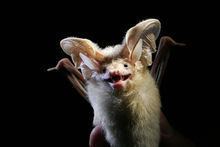Scientific name Otonycteris hemprichii Higher classification Otonycteris Order Bat | Family Vespertilionidae Phylum Chordata Rank Species | |
 | ||
Genus OtonycterisPeters, 1859 Similar Otonycteris, Bat, Botta's serotine, Rüppell's pipistrelle, Scotoecus | ||
Desert long eared bat getting a drink
The desert long-eared bat (Otonycteris hemprichii) is a species of vesper bat.
Contents
- Desert long eared bat getting a drink
- Distribution and range
- Taxonomy
- Description
- Ecology and behavior
- Diet
- Courtship and breeding
- References
Distribution and range
The single species, O. hemprichi, occurs in the desert zone from Morocco and northern Niger through Egypt and the Arabian peninsula to Kazakhstan, Kyrgyzstan, and Pakistan to as far east as north-west India.
Taxonomy
The systematic position of Otonycteris is unclear, but chromosomal analysis suggests close affinity to Barbastella and Plecotus
Description
Head and body length is about 73–81 mm, tail length is about 47–70 mm, and forearm length is 57–67 mm. Several authorities gave the weight of two adult males as 18 to 20 grams. The large ears, about 40 mm in length, are directed nearly horizontally and are connected across the forehead by a low band of skin. Five female specimens revealed two pairs of pectoral mammae, a unique condition in mammals. It is not known if both pairs are functional.
The coloration above is pale sandy to dark brown; the underparts are usually whitish. The skull and teeth of Otonycteris resemble those of Eptesicus
Ecology and behavior
This bat occurs normally inhabiting extremely barren and arid regions. Its habitat are xeric, sparsely vegetated and rocky. In the Negev Desert a pair was found roosting in a rocky crevice on a hill. This bat has also been found in buildings.
Otonycteris hemprichii reportedly has a slow, floppy flight.
Diet
Based on an analysis of its body mass, low aspect ratio, and low relative wing loading, the species is predicted to be carnivorous. Observations in Kyrgyzstan indicate that the bat forages close to the ground, using echolocation to detect large flying or surface-dwelling invertebrates, and feeding mostly on arachnids and orthopterans that are seized directly from the ground. A study in Israel found that up to 70% of the bat's dropping contain scorpion fragments, including the highly venomous Palestine yellow scorpion as well as other less venomous species. Laboratory observations indicate that the bats detect the scorpions by the noises they make as they walk. Once caught the bats bite the heads of the scorpion and frequently get stuck in the face by the scorpion's sting. When this occurs, no signs of toxicity have been recorded, suggesting that the bats are immune to the scorpion venom. Despite this, they will contort in pain after sustaining repeated successful strikes from the scorpions.
Courtship and breeding
Breeding colonies of 3-15 females have been found, and seven pregnant females, most with two embryos, have been collected in central Asia. Three pregnant females, each with two embryos, were found in a deserted hut in Jordan.
